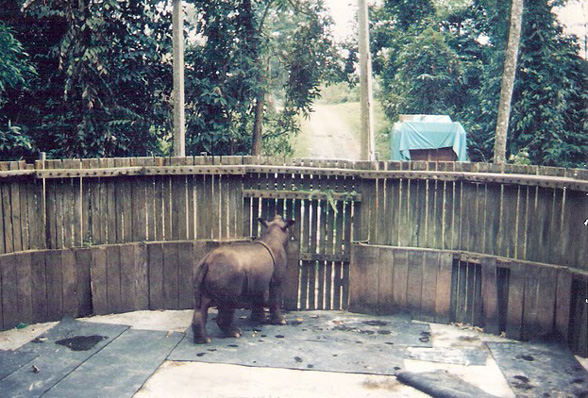The Star, February 6, 2007
Story by TAN CHENG LI

Because of their rarity, elusive nature and the harsh terrain of their habitat, little is known about the species’ biology, habitat needs and reproductive behaviour. This has stymied breeding efforts.
“Their reproduction and physiology differ from other species, which explains the low reproductive success. We had to go back to the drawing board and build up from the ground,” says Dr Nan Schaffer, who has worked with all five rhino species in the past 25 years.
In the early years of the captive breeding programme, many rhinos in American zoos died and only later did scientists learn that the animals survive on a wide variety of leaves, fruits and minerals found in natural salt licks. Of the seven Sumatran rhinos sent to the United States in the 1980s, only two are still alive.
Schaffer says scientists also discovered later on that rhinos seek shaded habitats and are almost never in the harsh sun.
The Sungai Dusun centre in Selangor, as it turned out, was not exactly a conducive breeding spot because trees were felled during the construction. The rhinos’ paddocks were also too small. Being solitary animals, Sumatran rhinos need large enclosures, unlike Indian rhinos which can be herded together.
Newer breeding facilities, such as the Sumatran Rhino Sanctuary at Way Kambas National Park in Sumatra, are better designed. The sanctuary sprawls over 100ha and each of the four rhinos there has a 10ha forested enclosure.
Over the years, breeders have employed various techniques, including those used to boost human fertility, to get caged rhinos to reproduce.
Shaffer was instrumental in the success of artificial insemination in the white rhinoceros and the birth of Andalas, the world’s first captive-born rhino.
After repeated failed pregnancies in the female adult rhino, Cincinnati Zoo staff sought Schaffer’s help. She advised them to use progesterone to help bring the pregnancy to term. It worked, resulting in the birth of Andalas in 2001.
Shaffer also developed a technique to extract sperm from male rhinos consistently, for artificial insemination.
The trick, she reveals, is to use an electrical probe to stimulate the rectum and spine, which then causes the rhino to ejaculate. “Yes, there is nothing romantic about it,” she quips.
Another hurdle in rhino breeding is that the animals will attack each other and must be kept apart except when the female is in oestrus and ready to mate. So keepers must monitor the animal’s behaviour and fertile periods to determine the right time to put them in the same enclosure for mating.
“It took us 20 years to understand all this. It was very frustrating as we had to learn and perfect many techniques,” says Schaffer.
“Breeding centres the world over contributed to the body of knowledge on keeping rhinos in captivity. Each facility developed a piece of the puzzle and it all came together in Cincinnati Zoo.
“Sepilok was the first place to successfully bring the animals together without them attacking each other. Without this knowledge, the Cincinnati Zoo births would not have happened.”
Cincinnati Zoo is the sole success story in rhino captive breeding. Andalas got a sister in 2004 and his mother Emi is expecting another male calf in April.
Why has the success of Cincinnati Zoo not been replicated? “Successful breeding depends on investment, expertise and motivation,” says Schaffer. “Cincinnati Zoo has a team of dedicated staff and a body of expertise (such as a reproductive expert and vet) not seen in any other breeding centres, and it was prepared to put in huge investments.”
Rhino scientists believe they have more or less perfected rhino breeding techniques but the problem now is this: only a few captive animals remain and most are old or have various ailments linked with long-term confinement. Many captive female rhinos have tumour growths in their reproductive tracts which interfere with pregnancies. Lack of breeding activity is believed to be the cause.
If captive breeding is to continue, healthy animals are needed.
After the deaths of the Sungai Dusun rhinos in 2003, there was a proposal to trap a female rhino from Peninsular Malaysia and send it to Cincinnati Zoo for breeding but the Department of Wildlife and National Parks withdrew its initial agreement on the project.
Now, hopes for another captive breeding success is pinned on the healthy and young stud Andalas. In mid-February, he will leave his home at Los Angeles Zoo for Way Kambas, to start his own family. It is a risky move – the journey to Sumatra will be a long and stressful, and for the first time, Andalas will be exposed to the wild tropical rainforest and with it, potentially dangerous foreign parasites.
But then again, it is a risk that has to be taken for back in LA Zoo, Andalas will never ever have a mate. At least in Sumatra, there is still a chance for him to help save his own kind.